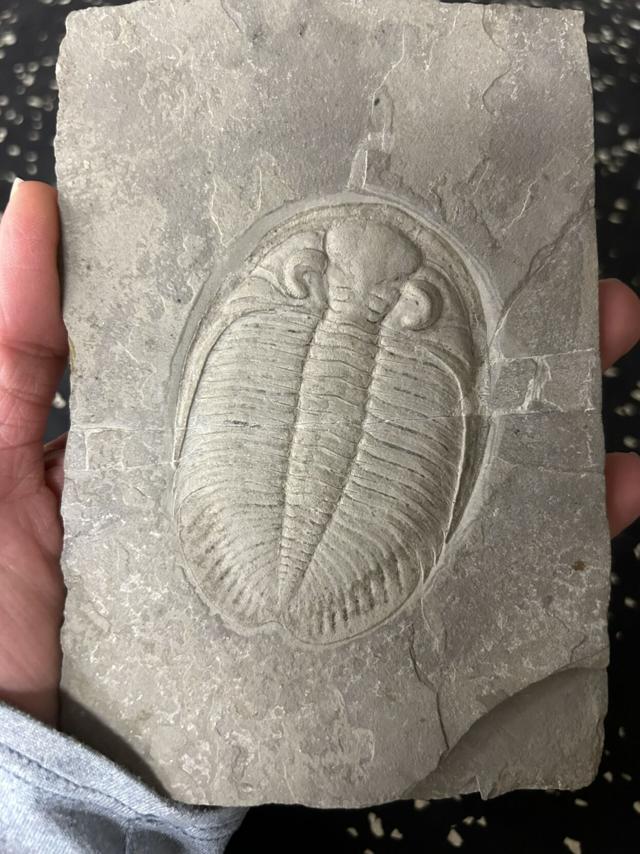Madison woman gets new species named after her (WI) (“Waukeshaaspis eatonae”)
Madison Magazine ^ | November 15, 2024 | Maggie Ginsburg
Posted on 11/15/2024 6:39:35 AM PST by Diana in Wisconsin
Imagine this: It’s 1984, and two amateur paleontologists are digging in a quarry near Waukesha when they discover what ultimately turns out to be about 2,000 invertebrate fossils — things like soft-bodied worms and shelled creatures like snails and tiny crustaceans, essentially entombed. They are an astonishing 430 million years old and many have never been seen before. Forty years later, as researchers are still identifying and classifying new species from the rare collection, one of them names a little trilobite after you.
“It still hasn’t sunk in. It is such a huge, huge honor,” says Carrie Eaton, who is the curator of the University of Wisconsin Geology Museum, which is home to over a quarter million objects of geological, paleontological and meteoritical significance. Eaton got the shock of her career earlier this year when researcher Kenneth Gass told her he was naming a newly classified species of arthropod the “Waukeshaaspis eatonae” — as in Eaton — in recognition of her tireless work preserving the fossils that date back to the Silurian time period. The academic paper, published yesterday in the Cambridge University Press by Gass and Argentina-based researcher Enrique Alberto Randolfe, made the naming official.
“I was so completely bowled over in part because curatorial work happens so far behind the scenes,” says Eaton, who’s been in her role about 15 years and wears a number of hats, including conserving, preserving, cataloging, digitizing and essentially making these rare items more accessible to researchers. “We’re the ones working behind closed doors and down in the basement making all of the work that gets press possible. So it still hasn’t even really sunk in because it just seems so unreal that someone would name a species after a collections manager.”
It’s also rare to have a species named after a woman, Eaton says. “Scientific names in general show a pretty significant bias towards scientists and especially white males,” Eaton says. Notably, she adds, her colleague Dave Lovelace, the Geology Museum’s scientist, is in the process of naming some new species himself — everything must go through the International Commission on Zoological Nomenclature — and he’s using native languages. “The new reptile that he and his team named in cooperation with the Northern Arapaho was one of the first fossil species ever to be named in native language,” Eaton says.
It’s an honor to be named at all, but Eaton is especially jazzed about this particular collection. In many cases, it’s not just the hard exoskeletons that are preserved, but the soft parts. “There are preserved worms were you can actually see the rings,” she says. “Some of these trilobites, like the ones discussed in this paper that just came out, actually have preserved gut contents in them. Like, their intestinal tract is in there.”
It’s equally cool to know the trilobite named in her honor hails from Wisconsin. “This collection tells the story about what the environment was like in Wisconsin 430 million years ago,” says Eaton of the biota, which is classified as a Konservat-Lagerstätten — a site of exceptional preservation that has both quantity and quality.
Although the the museum acquired the specimens in the 1980s, much of the collection had been dispersed on loan to researchers for study. In 2004, when museum director Richard Slaughter was hired, he recalled all of it so that it could be inventoried, digitized and made as accessible as possible. When Eaton was hired in 2009, she dove in. “I had whole teams of students applying little numbers and cataloging and curating and entering data into our database,” she says. “It’s not just a labor of love, it’s a labor of duty to get all of these organisms and all of this material better organized so that people can come and look at it and research it and write these papers.”
That’s what Eaton has been doing, not just for this collection but for all of the museum’s holdings, for the past 15 years — which may seem like a long time, but probably isn’t, in the grand scope of 430 million years. The process has been expedited in recent years in part due to evolving technology — even just being able to email researchers instead of relying on snail mail has sped up the process — leading to more papers published on the collection than ever before. Eaton says she struggles to accept that she is deserving of this honor, but it helps that Gass sent a nice note thanking her for all of these hours she’s put in and the hoops she’s jumped through to reunite this collection and care for it so well, in turn making his job easier.
“I wish every person who puts in this kind of work on collections out there could be recognized in the same way,” Eaton says.
TOPICS: Education; History; Hobbies; Science
KEYWORDS: history; hobbies; science; wisconsin
Dear FRiends, Please use this temporary link to donate by credit card via Authorize.Net:
Or click here to donate by PayPal
Or by mail to: Free Republic, LLC - PO Box 9771 - Fresno, CA 93794
Hopefully, we'll have our normal CC system up and running again soon. Thank you very much for your loyal support!

To: SunkenCiv
2 posted on 11/15/2024 6:40:20 AM PST by Diana in Wisconsin (I don't have, 'Hobbies.' I'm developing a robust Post-Apocalyptic skill set.)
To: Diana in Wisconsin
That is so beautiful! Nice story.
3 posted on 11/15/2024 6:45:40 AM PST by leaning conservative (snow coming, school cancelled, yayyyyyyyyy!!!!!!)
To: Diana in Wisconsin
There are always fossils of things claimed to be millions of years old, but is there is any real proof for this?
4 posted on 11/15/2024 6:46:34 AM PST by oldtech
Disclaimer: Opinions posted on Free Republic are those of the individual posters and do not necessarily represent the opinion of Free Republic or its management. All materials posted herein are protected by copyright law and the exemption for fair use of copyrighted works.
FreeRepublic.com is powered by software copyright 2000-2008 John Robinson

 By Free Republic | Created at 2024-11-15 14:48:13 | Updated at 2024-11-23 10:38:43
1 week ago
By Free Republic | Created at 2024-11-15 14:48:13 | Updated at 2024-11-23 10:38:43
1 week ago








